Online fashion marketplace: How to start your own marketplace
You’re looking for tips on starting an online fashion marketplace? You’ve come to the right place!
Throughout this article, we’ll walk you through some of the crucial elements and strategies that you may want to consider when starting an online fashion marketplace.
To be honest – selling on marketplaces is no longer an “if” question. It has become simply a matter of “when and how are we going to do it”.
The COVID-19 pandemic has “pushed” everything online and retailers are adjusting to this new business pace at a lightning-fast speed.
Online sales have skyrocketed and there’s a huge shift in how shoppers are buying now.
If there ever was a time to go online – now seems an ideal option.
And if you’re in need of help developing your new online marketplace – be sure to reach out to us and ask us for some free consultation!
In any case, let’s jump into the topic and check out what are some necessities when starting an online fashion marketplace!
A fashion marketplace is always in fashion!
The eCommerce fashion industry is booming and there’s a ton of data to support that.
According to Shopify’s fashion and apparel industry report, it’s headed in the right direction. Worldwide revenue is expected to rise from $481.2 billion in 2018 up to $712.9 by 2022.
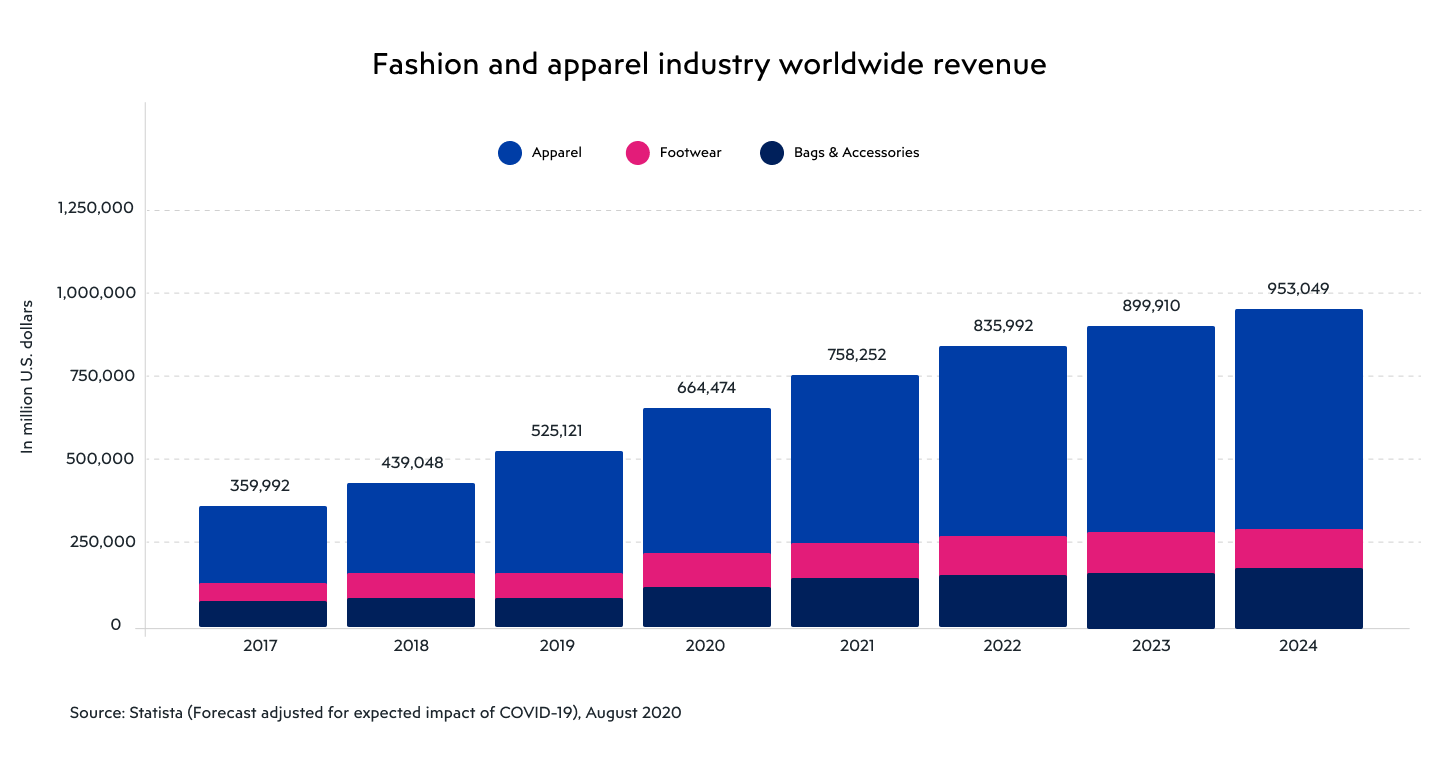
There are several factors that enable this rapid growth of the whole industry:
- Expanding global market, a great focus is on the East
- The Internet has become largely accessible and there’s a huge rise in the usage of smartphones
- New middle-classes are emerging throughout the world
- New innovating technologies are appearing constantly
The barriers to starting an online fashion marketplace are extremely low, and we’re witnessing a large increase in the number of online fashion retailers.
Whether you’re trying to niche down to the footwear segment, clothes segment, bags, or even luxury and jewelry, there’s a growing demand for every single one of these products.

When looking at it from the perspective of the owner of an online fashion marketplace, this may seem like a wind in one’s sails.
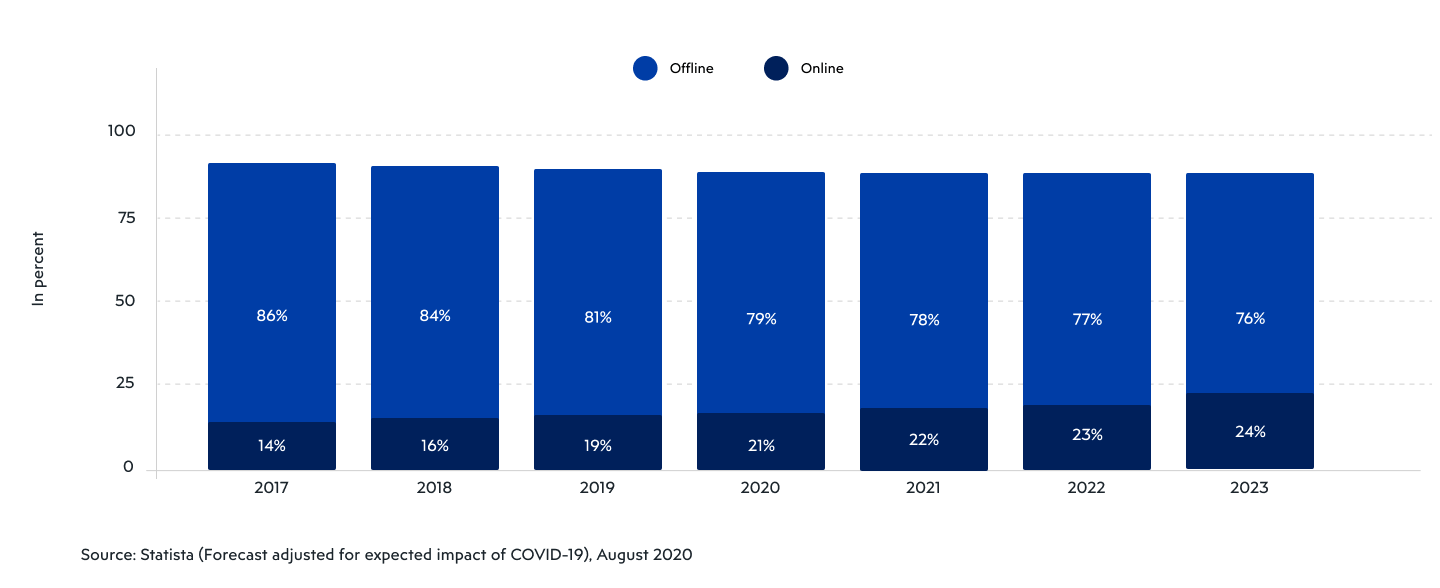
As seen in the graph above, there’s a shift in the way people are buying fashion products.
There’s a growing interest in using online channels, resulting in even more reasons for starting an online fashion marketplace.
What’s trending in the fashion marketplace space?
Here, we’ll take a look at what are the current trends in the fashion marketplace space and fashion industry in general.
Regardless of the uncertainty which lies in the months and years to come, there are some concrete directions in which the fashion industry is going.
When starting an online fashion marketplace, you’ll certainly want to pay attention to them.
So, let’s check them out.
Digitalization is on the rise
According to McKinsey’s research, digitalization in the fashion industry is growing in importance.
New technologies are transforming the way customers are shopping and engaging with brands, and there’ve been some significant investments in digital over the past few years.
Both new and emerging brands are focusing on improving their online presence and they’re using big data and eCommerce analytics to craft personalized shopping experiences.
Generally speaking, digitalization is currently at its’ all-time high regarding investments, and by many indicators, it will continue to grow across all industries.
Sustainability is one of the key objectives
Besides digitalization, sustainability stands as one of the major trends of the fashion industry.
There’s a growing number of customers that are concerned about the future of the planet and ecological sustainability.
Brands with higher sustainability and a pro-ecological approach are enjoying more attention from their customers.
Adidas is a great example here, as they used plastic trash and transformed it into material from which they created shoes and clothing.
As another example we have Chanel. They invested in the startup Evolved by Nature, which replaces synthetic additives with alternatives that are more environmentally friendly.
The customers today want to see the brands to care.
They want them to be responsible and to make an impact on the environment in a positive way.
So, when starting an online fashion marketplace, consider having sellers that can offer products created in a sustainable fashion.
Voice search is becoming more popular
Just imagine you’re driving and shopping for some products at the same time.
Not that long ago, it didn’t seem possible, but as we progress further down the road, new possibilities are opening up at a rapid pace.
Virtual assistants are creating a huge difference in people’s everyday lives.
According to Nielsen, 1 out of every 4 households in the US now has at least one smart voice assistant, such as Amazon’s Alexa or Apple’s Siri.
And now – they’re being used for shopping.
Gartner estimates that brands that optimize their eCommerce stores for voice search will see an increase in their profits by up to 30%!

On the graph above, you can see how the team from Voicebot.ai predicts Voice eCommerce sales are going to rise in the US and UK.
Voice search is bringing a bit of disruption in the world of traditional SEO and brands such as yours will need to adapt to these new trends if they’re aiming to take advantage of new technologies.
Having SEO in mind when starting an online fashion marketplace is extremely important, as it has a significant impact on your online presence and overall visibility.
P.S. We already wrote about voice search optimization in eCommerce, so check it out and make sure you’re well-prepared!
The revolution in mobile commerce
Mobile shopping is reaching new heights and it has made a large impact on the fashion industry.
A growing number of customers are turning to their smartphones when it comes to online shopping.
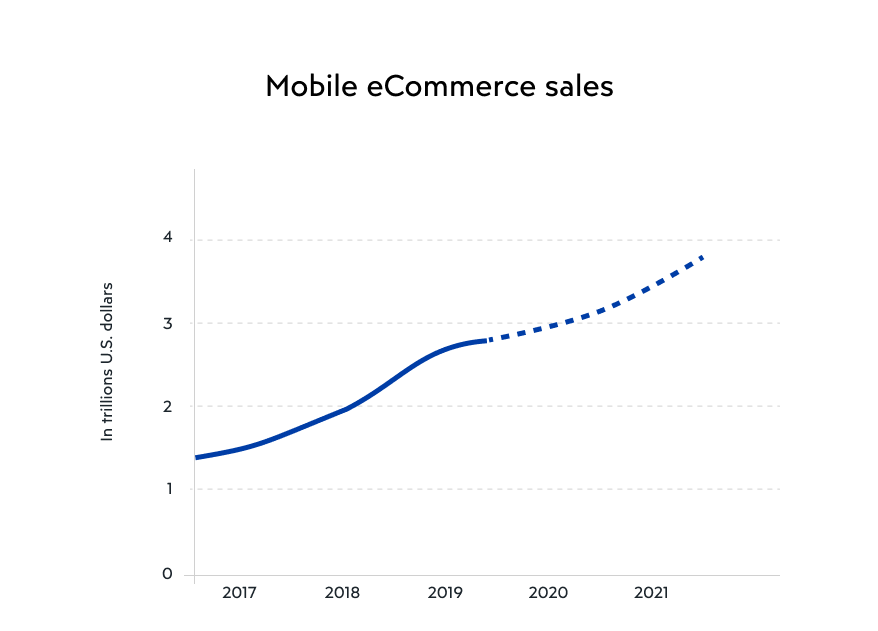
To seize this opportunity, you’ll want to keep pace with the growing trend of mobile commerce.
Some of the first steps towards this are to ensure that your fashion marketplace website is mobile-friendly, that your mobile shopping experience is at a high level, and that the payment process goes as smoothly as possible.
We’ve covered the whole mCommerce revolution in one of our articles, so please check it out to find more useful information that’ll help you get started.
There are a few more trends regarding the fashion industry, and here we’re focusing on some of the most important when it comes to the domain of online.
And before we move on to the next chapter – check out our ultimate list of eCommerce features you may want to have on your online fashion marketplace!
Let’s check out some concrete strategies that’ll put your online fashion marketplace in the spotlight.
Personalization is a must-have strategy for a sustainable fashion marketplace
We’ve all come to like this trend as the customers and now it’s time for you, as the owner of an online fashion marketplace, to provide your customers with the same.
To support this claim, SmarterHQ pointed out several important statistics on personalization, so let’s take a look.
- 80% of customers are more likely to purchase a product or service from a brand that provides personalized experiences.
- 90% of customers are willing to share their behavioral data if additional benefits are provided that make shopping cheaper or easier
- On average, 71% of consumers feel frustrated when their shopping experience is impersonal.
- 89% of digital businesses are investing in personalization, including Coca-Cola, Fabletics, Netflix, Sephora, USAA, and Wells Fargo.
- Personalization can reduce acquisition costs by as much as 50%, lift revenues by 5–15%, and increase marketing spend efficiency by 10–30%.
By tracking the user behavior on your fashion marketplace, you’ll be able to create personalized shopping experiences for every single customer.
This process may start with recommended products being personalized, but it has the potential to go far beyond that.
Let’s just look at one brilliant example.
Here, you can see how Netflix personalized the cover images based on the user’s past behavior.
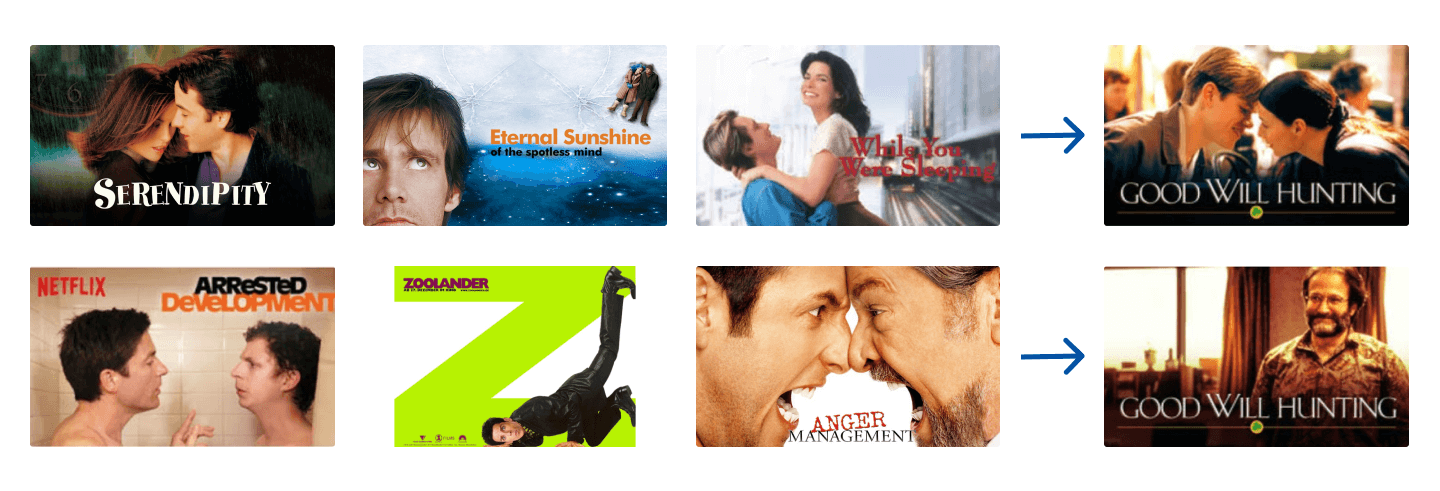
There are a few platforms that offer this level of personalization, and the one we’re working on is Pimcore – a digital experience platform that’ll help you personalize all forms of your communication and deliver highly relevant content.
To showcase just how powerful Pimcore is and how it can help you, we’ve created a guide to Pimcore’s personalization engine.
Check it out and try to picture your website using this level of personalization (it can do almost anything).
As we move forward, more shoppers expect this level of personalization in the eCommerce fashion industry.
Let’s take ASOS as an example here.
For instance, if your customers have either browsed or shopped men’s clothing, it’s useful to craft a meaningful homepage experience for them.
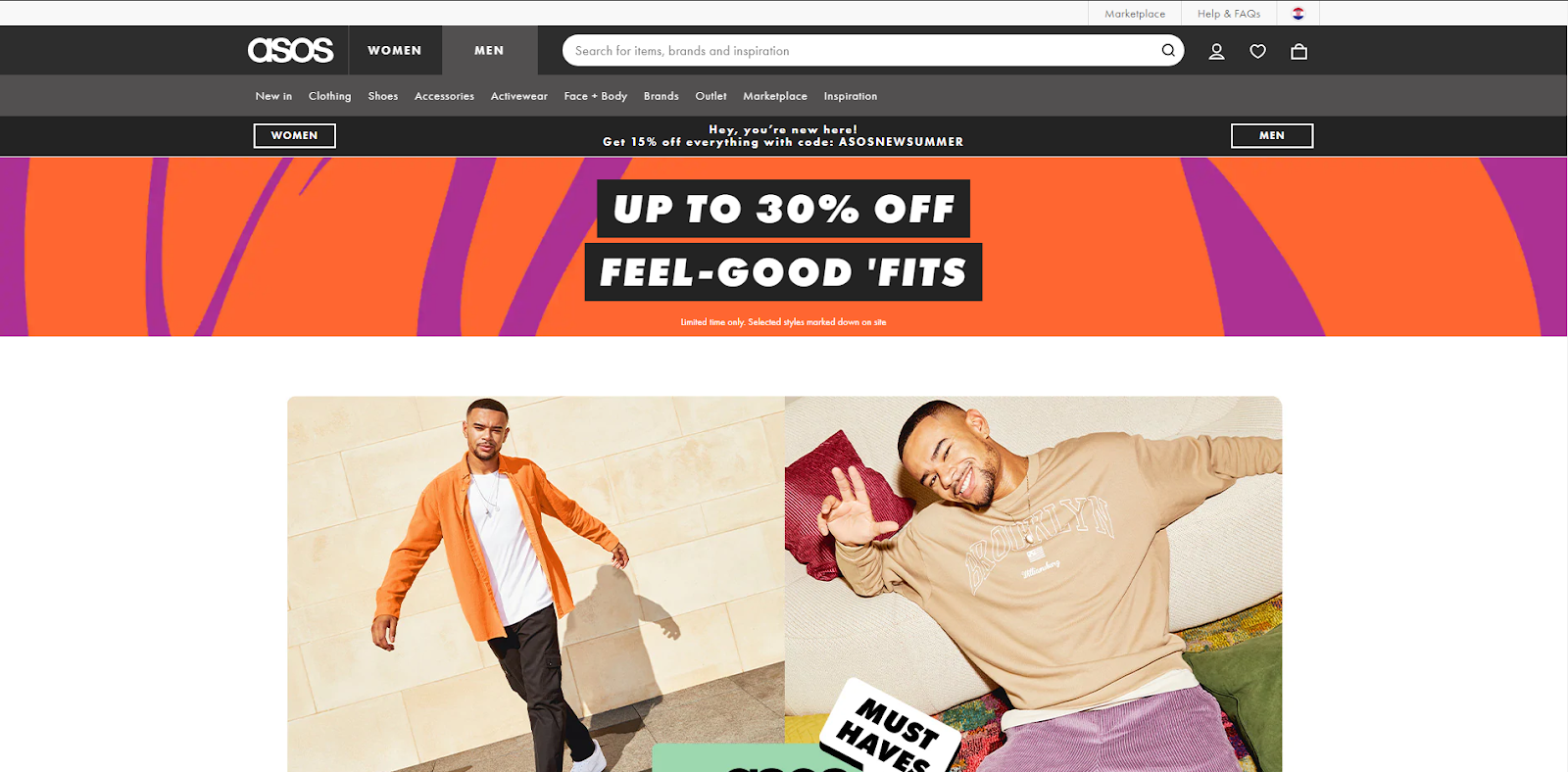
The next time when those customers land on the homepage, they’ll be presented with personalized homepage experience.
As they’ve already shopped for men’s clothing or maybe browsed and added a few products in the shopping cart, there’s an indication that they may be interested in men’s clothing and it’s beneficial to provide them with relevant content.
The extent of personalization is constantly changing.
We’re witnessing a growing number of factors we can personalize in order to make the customer’s shopping experience more enjoyable.
P.S. We’ve analyzed ASOS in one of our articles and talked more about features that make ASOS a successful eCommerce business as it is today. Check it out!
Consider having an influencer marketing strategy
When it comes to influencer marketing, there’s a huge presence in the fashion industry.
The word about fashion spreads quickly and influencers are here to carry the message.
But how effective is it?
According to the influencer marketing report in 2019, 1 out of every 4 sponsored posts is related to fashion.
The audience on Instagram has shown a keen interest in scrolling through the feed and shopping directly from the feed.
It’s safe to say that Instagram has created many opportunities for all fashion brands, especially thanks to its focus on the visual.
And here you can rely on influencers to be one of your main helpers.
They won’t just help you sell your products – they’ll give you an idea of what your target audience wants.
For example, after an influencer posts an arranged sponsored post for your brand, analyze the post – go through the comments and check out what the audience thinks.
They may even spread the word of your brand to some uncovered audiences, bringing in more potential customers for your fashion marketplace, and improving your brand image in general.
Another interesting claim is that influencers have the ability to generate a need for a specific product.
They’re known for their content curation skills and they know how to keep their audience engaged.
Meaning, you could collaborate with influencers to increase demand for some of your products or collections.
They usually have a great impact on a portion of their followers and it could prove to be extremely beneficial for your fashion marketplace.
Moreover, your collaboration with influencers will make it easier for you to compete with the rest of the industry.
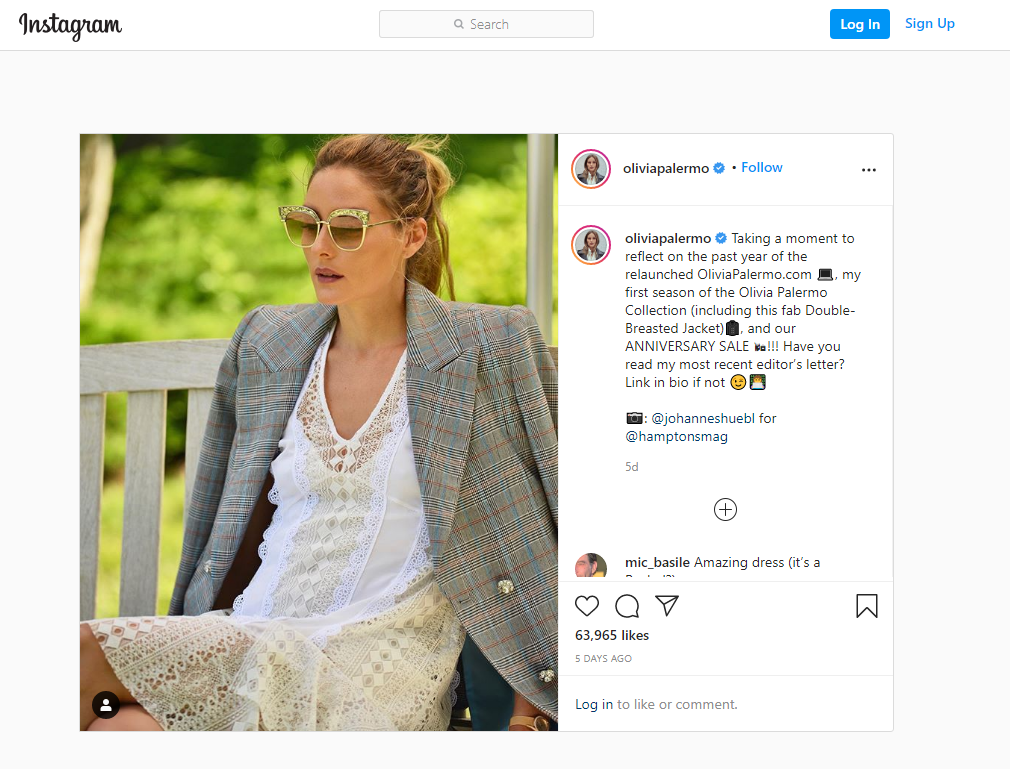
Here, you can see how Olivia Palermo is promoting her own fashion brand through Instagram posts.
She’s included some important information in her caption and ended it with a short call-to-action.
You could try to identify some areas in which your competitors are lacking and craft strategies accordingly.
All in all, influencer marketing will make it easier for you to showcase your brand strengths and create a positive brand image.
But a number of influencer campaigns fail because of the wrong selection of influencers and lack of understanding of their audience.
Flaunter created a simple guide on how to work with influencers, so if you choose to go with that strategy – be sure to check out their guide.
Social media needs to be a part of your omnichannel strategy
The importance of social media in the fashion industry is undeniable.
Fashion brands have already recognized how beneficial it is to create a voice for their brand and engage with their customers on social media.

Instagram, to be specific, is one of the best social networks for fashion brands.
It’s highly visual and there’s just a huge amount of fashion-related content being created on a daily basis.
Creating content for Instagram, for example, has become crucial for many businesses.
To make it a bit easier for you to start, here you can find an Instagram story ad maker that’ll help you create short video ads for this social network.
To get you started, we’ll name some of the benefits of using social media as a part of a marketing strategy, especially if you’re running an online fashion marketplace.
Cultivate brand image
Social media makes it possible for your online fashion marketplace to cultivate the image so that your customers get a clear picture of what your brand is and what it stands for.
You’ll be able to leverage both visual and textual messages, presenting your customers with specially curated content that represents your brand.
Once your customers get to know your brand, they’ll be more likely to shop on your online fashion marketplace than on the marketplace of a lesser-known competitor.
Just remember how you can automatically associate a certain brand with some human characteristics.
Connect with your customers
The impact of social media in the fashion industry has closed the gap between the brands and the customers.
You, as the owner of the whole fashion marketplace, can take full advantage of social media to connect with your customers.
You could (and you should) respond to all the comments on your social media posts, host giveaways, repost your customers’ photos and testimonials, and so much more.
Social media will be of use to you as a great channel for customer service.
You’ll be able to solve their objections by talking with them directly and clarify all the underlying issues.
But the most important aspect of social media for you is going to be data.
You can use social media to gather data from your customers, such as the information on what do they want to see, what do they like when they’re shopping and what kind of products they really loved.
All in all, it’s a great listening tool.
Increase traffic on your fashion marketplace
It’s obvious that you shouldn’t limit your digital presence strictly to your website.
And you definitely don’t want Google search to be your one and only source of traffic.
While growing your social media presence, you’ll experience an increase in your website traffic, later leading to an increase in revenue.
You’ll achieve this through paid ads, engaging and personalized content, influencer marketing campaigns, and many other social media strategies.
One of the main aspects of all social media is its visual factor, making it perfect for any fashion brand to express itself.
Every day, there are more and more social media users and it’s vital that you take advantage of the role of social media in the fashion industry to drive more traffic to your online fashion marketplace.
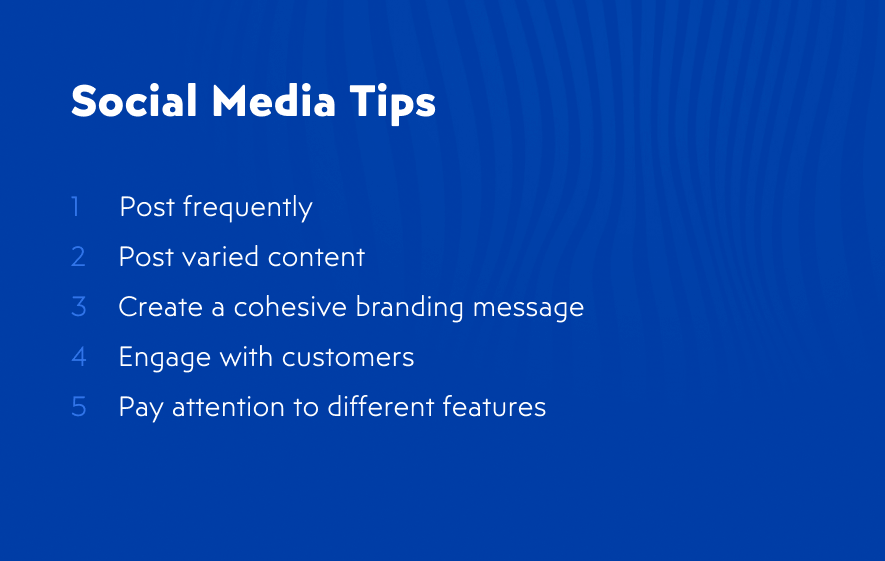
Leverage blogs to attract new customers
Insightful and interesting fashion-related blogs can most definitely add fuel to your online fashion marketplace fire.
When starting an online fashion marketplace, think about creating a blog strategy.
Now, why should you focus on blogs if you’re running an online fashion marketplace?
Blogs are one of the most effective ways to connect with your audience and spread the word about your practices, company news, and much more.
Being a fashion-related blog, you could even create style guides, write fashion news, and newsletters to help retain your customers and even acquire some new ones!
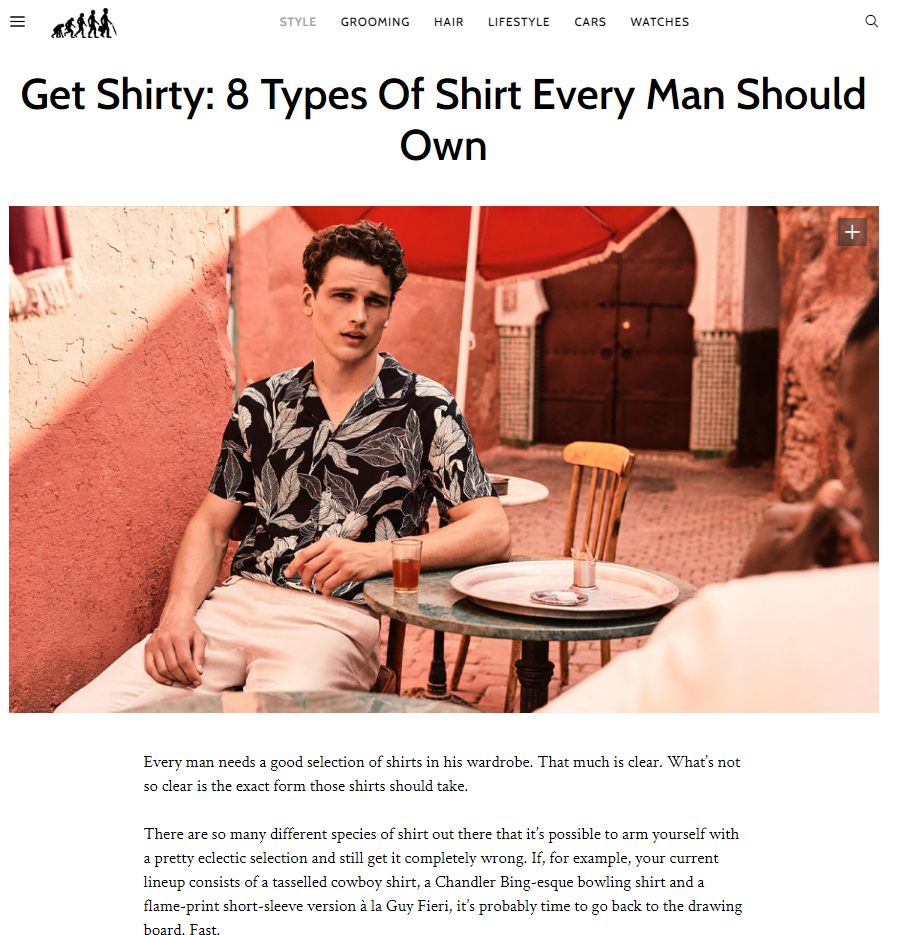
Reaping the benefits of eCommerce content isn’t as simple as writing a few hundred words and linking to a few product pages.
The best blogs, whether they’re associated with a fashion brand or they’re a solo venture, produce content that is unique, helpful, educational, and in-depth.
This means that you’ll find no basic posts that you can find anywhere else.
What kind of content should you produce for your fashion marketplace blog?
You should aim to produce content that your visitors (and potential customers) have a genuine need for, either to improve their lives or simply to enjoy in your writing.
An example: “Why Wear Eye Makeup?” sounds like a pretty boring topic, and it probably won’t sell anyone on mascara or eyeliner.
But “15 New Ways to Wear Eye Makeup” may sound a bit interesting, it promises the reader an opportunity for learning and probably goes in-depth on a specific topic.
You can already see the difference.
And keep this in mind – the posts you’re creating should always be related to your business.
For instance, if you’re selling men’s suits and your whole fashion marketplace is based around men’s formal wear, blogging about men’s suits and different formal styles makes sense.
But if you would write a blog post on women’s fashion, your audience would most probably skip that post and move on, maybe even abandon the blog.
Blogging can be a fun and useful way to connect with your audience, provide them with more relevant information, and create a sustainable community of like-minded people.
Be sure to use it!
What’s your next step?
We’ve laid down the information you’ll want to know before starting an online fashion marketplace.
Let’s go through it once more.
- Don’t be afraid of digitalization!
- Strive towards sustainability
- Focus on new technologies and trends such as voice search and mobile commerce
- Personalize all of your communication
- Consider collaborating with influencers
- Leverage social media to nurture your brand image
- Use blogging as an effective tool for retaining and attracting customers
There’s a lot more to be said regarding each of these bullet points, and you can expect us to cover those topics in our upcoming articles!
And if you’d like to know more – we’ve got something prepared for you. Learn more on how to get ready for starting the online marketplace!
Starting an online fashion marketplace isn’t simple, and we’re aware of that.
We’re here to help you on your journey and make it as easy and stressless for you as possible.
We’re proficient in online marketplace development and our goal is simple – your success.
Feel free to reach out to us, we’d be happy to give you a free consultation on your ideas, and we’d definitely like to hear them.






